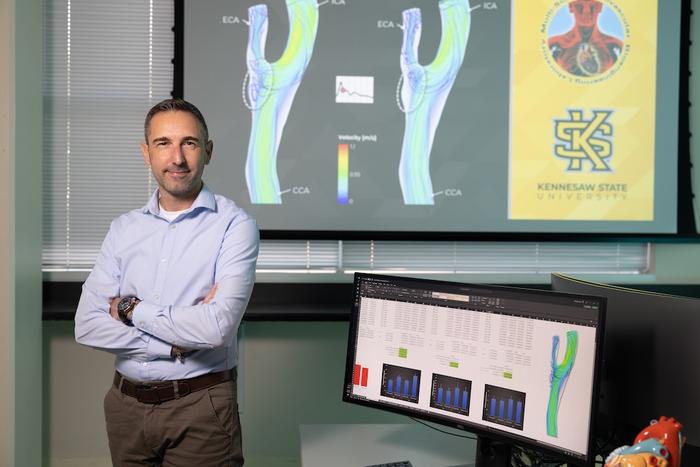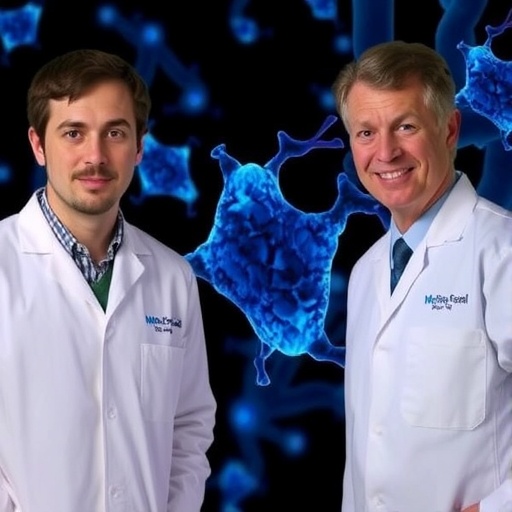
Kennesaw State University’s esteemed mechanical engineering professor, Philippe Sucosky, has achieved a significant milestone in his research endeavors by receiving the prestigious Institutional Enhancement Award from the American Heart Association (AHA). This award, designed to foster innovative solutions in cardiovascular research, seeks to propel his study on a critical cardiovascular condition known as bicuspid aortic valve disease and explore potential therapeutic avenues. The acknowledgment from such a reputable organization not only underscores the relevance of Sucosky’s work but also demonstrates the growing recognition of the intersection between engineering and medical sciences.
At the core of Sucosky’s project is an inventive concept titled “A Novel Microphysiological Valve-on-Chip for Elucidating the Mechano-Etiology of Bicuspid Aortic Valve Disease.” This ambitious initiative aims to construct an advanced device that replicates the anatomical and functional characteristics of the bicuspid aortic valve, providing insights into how abnormal mechanical stresses contribute to the premature degradation of this crucial heart structure. As research in this area continues, Sucosky’s team endeavors to reveal the intricate biological dynamics that trigger the early onset of valvular disease, which often leads to serious health ramifications.
The device under development by Sucosky’s team in the Multi-Scale Cardiovascular Bioengineering Laboratory (MSCBL) creates a sophisticated in-vitro platform capable of mimicking the environmental conditions faced by both normal and diseased aortic valves. By simulating the unique biomechanical forces encountered by the bicuspid aortic valve, this research aims to elucidate the biological mechanisms responsible for premature calcification. Such advancements could play a pivotal role in identifying potential treatment options and therapeutic strategies to mitigate the disease’s progression.
Bicuspid aortic valve disease presents a significant challenge in cardiovascular health. Unlike typical heart valves that undergo calcification around the age of 65, individuals born with a bicuspid aortic valve experience calcification much earlier, often in their 30s. The abnormal structure leads to undue strain on the heart and increased risk of complications, frequently necessitating surgical intervention. This rampant early calcification not only accelerates disease progression but also complicates treatment options, as replacement valves generally exhibit limited lifetimes, prompting the need for multiple surgical procedures over a patient’s lifetime.
Professor Sucosky emphasizes the profound impact this condition inflicts on patients, particularly concerning their quality of life and the necessity for repeat procedures at a young age. He seeks to unravel the underlying processes that contribute to this hastened calcification to devise innovative strategies aimed at delaying or entirely halting the disease’s progression, with the ultimate goal of improving patient outcomes and reducing surgical burdens.
The research spearheaded by Sucosky has attracted considerable attention from both the AHA and his academic peers at Kennesaw State University. Dean Lawrence Whitman of the Southern Polytechnic College of Engineering and Engineering Technology has praised Sucosky’s initiatives as exemplary within the domain of intersectional research. His work promises to push the frontiers of cardiovascular engineering while simultaneously addressing vital societal healthcare challenges.
Central to Sucosky’s research is the hypothesis that the aberrant morphology of the bicuspid valve induces irregular blood flow patterns, thus exerting abnormal mechanical stresses on the valve tissue. These non-physiological forces are hypothesized to be a substantial factor in the aggressive calcification typically associated with this valvular condition. To rigorously test this hypothesis, Sucosky’s laboratory is advancing a groundbreaking valve-on-chip technology capable of replicating the mechanical dynamics present within the cardiovascular system.
Through this innovative device, researchers can delve deeper into the mechanobiological relationships impacting valve tissue health. Sucosky is hopeful that his investigations will not only enhance the understanding of bicuspid aortic valve calcification but also extend insights into other broader cardiovascular diseases, ultimately laying the groundwork for future pharmaceutical interventions aimed at repositioning how we approach heart valve disorders.
Sucosky believes that tackling this critical area of research could lead to the development of drug-based therapies targeting the calcification process, thereby sparing patients the need for multiple invasive surgeries. By conceptualizing and actualizing these non-surgical alternatives, there is potential not just for innovation in treatment paradigms but also for a significant reduction in healthcare costs and patient morbidity associated with repeated surgical interventions.
The approximately $200,000 funding granted by the AHA over two years enables Sucosky and his MSCBL team to further their heart research significantly. This endeavor is not carried out in isolation; it involves a collaborative environment that includes undergraduate students actively participating in the design and simulation stages of the device. Additionally, the project benefits from the expertise of external collaborators, including Dr. Kartik Balachandran from the University of Arkansas, whose foundational work has informed the current research pathway.
Collaborative efforts are deemed essential by Sucosky, who recognizes that comprehending the mechanical forces at play requires an integrated approach engaging engineers, biologists, and clinicians alike. The insights garnered from this interdisciplinary collaboration are expected to inform both the creation of medical treatments and the refinement of surgical approaches tailored to the unique requirements posed by patients with bicuspid aortic valve disease.
With an eye towards expanding the implications of his research, Sucosky plans to turn his focus towards additional cardiovascular conditions that might also be influenced by aberrant hemodynamics, such as aneurysms and atherosclerosis. By developing a versatile research tool capable of exploring various cardiovascular disorders, he aims to illuminate mechanisms underlying these conditions while simultaneously exploring novel treatment options.
In closing, Sucosky acknowledges that while the current project represents a long-term research pursuit, the potential impact on the medical community and patient care is immense. His innovative exploration into the mechanobiology of heart valve disease has the capacity not only to reshape our understanding of valvular conditions but could also result in a paradigm shift in how we approach a host of other cardiovascular diseases driven by mechanical forces.
His ongoing research efforts are a testament to the nexus between engineering and healthcare, highlighting a future where insights from biomechanics can lead to significant advancements in cardiovascular medicine.
Subject of Research: Bicuspid Aortic Valve Disease
Article Title: Innovative Valve-on-Chip Research Aimed at Unraveling Bicuspid Aortic Valve Disease
News Publication Date: [To be added]
Web References: [To be added]
References: [To be added]
Image Credits: Credit: Kennesaw State University
Keywords: Cardiovascular disease, Clinical research, Mechanical engineering, Surgery, Molecular structure, Circulatory system, Heart
Tags: advanced biomedical devicesAmerican Heart Association grantbicuspid aortic valve diseasecardiovascular research innovationearly onset of valvular diseaseheart valve disease studyKennesaw State University researchmechanical engineering in medicinemechano-etiology of heart diseasemicrophysiological valve-on-chipMulti-Scale Cardiovascular Bioengineering Laboratorytherapeutic avenues for heart conditions





